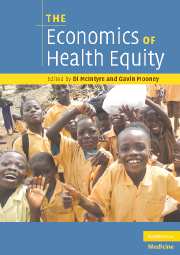Book contents
- Frontmatter
- Contents
- Contributors
- Biographies
- Acknowledgements
- Section 1 Introduction
- Section 2 Equity in general
- Section 3 Health service access
- Section 4 Equity and health systems
- Section 5 Lessons from individual countries
- 10 Equity in health financing, resource allocation and health service utilization in Brazil: past, present and future
- 11 Improving health-related information systems to monitor equity in health: lessons from Thailand
- Section 6 Future action
- Index
- References
11 - Improving health-related information systems to monitor equity in health: lessons from Thailand
Published online by Cambridge University Press: 22 August 2009
- Frontmatter
- Contents
- Contributors
- Biographies
- Acknowledgements
- Section 1 Introduction
- Section 2 Equity in general
- Section 3 Health service access
- Section 4 Equity and health systems
- Section 5 Lessons from individual countries
- 10 Equity in health financing, resource allocation and health service utilization in Brazil: past, present and future
- 11 Improving health-related information systems to monitor equity in health: lessons from Thailand
- Section 6 Future action
- Index
- References
Summary
Summary
In 2001, Thailand achieved universal access to health care. This has had a significant impact on the reduction in direct household payments for health care and promoted an equitable health care system. Empirical evidence from health information systems has revealed that there is now more equitable health care use across economic strata, the pro-poor nature of health care subsidies, especially for district health services provided by the Ministry of Public Health (MOPH), and a further reduction in the incidence of catastrophic and poverty impacts of health care expenditure. This is in line with the results of opinion surveys of public health administrators nationwide. The country-initiated National Health Accounts (NHA), compiled since 1994, are the backbone of resource tracking according to health care functions. In addition to the time-series NHA, monitoring and evaluation of equity in health care financial contributions is possible because of the long-standing, nationally representative household surveys conducted by the National Statistical Office (NSO), namely the Socio-Economic Survey (SES) and Health and Welfare Survey (HWS). Based on trust and mutual recognition and interests, a genuine partnership to improve the policy utility and equity monitoring capability of these two national databases has been fostered between the main user (MOPH) and data producer (NSO). Other large-scale regular surveys, conducted by health research institutes and various departments in the MOPH, contain quantitative data on health service use, payments for health care services, illnesses and health conditions, and general and specific health behaviour.
- Type
- Chapter
- Information
- The Economics of Health Equity , pp. 222 - 246Publisher: Cambridge University PressPrint publication year: 2007
References
- 3
- Cited by



